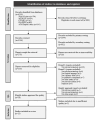The Uses and Experiences of Synchronous Communication Technology for Home-Dwelling Older Adults in a Home Care Services Context: Qualitative Systematic Review
- PMID: 39576979
- PMCID: PMC11624454
- DOI: 10.2196/59285
The Uses and Experiences of Synchronous Communication Technology for Home-Dwelling Older Adults in a Home Care Services Context: Qualitative Systematic Review
Abstract
Background: European health care systems regard information and communication technology as a necessity in supporting future health care provision by community home care services to home-dwelling older adults. Communication technology enabling synchronous communication between 2 or more human actors at a distance constitutes a significant component of this ambition, but few reviews have synthesized research relating to this particular type of technology. As evaluations of information and communication technology in health care services favor measurements of effectiveness over the experiences and dynamics of putting these technologies into use, the nuances involved in technology implementation processes are often omitted.
Objective: This review aims to systematically identify and synthesize qualitative findings on the uses and experiences of synchronous communication technology for home-dwelling older adults in a home care services context.
Methods: The review follows the PRISMA (Preferred Reporting Items for Systematic Reviews and Meta-Analyses) 2020 checklist for reporting. We conducted a cross-disciplinary search in 5 databases for papers published between 2011 and 2023 that yielded 4210 citations. A total of 13 studies were included after 4 screening phases and a subsequent appraisal of methodological quality guided by the Critical Appraisal Skills Programme tool. From these, prespecified data were extracted and incorporated in a 3-stage thematic synthesis producing 4 analytical themes.
Results: The first theme presented the multiple trajectories that older users' technology acceptance could take, namely straightforward, gradual, partial, and resistance laden, notwithstanding outright rejection. It also emphasized both instrumental and emotional efforts by the older adults' relatives in facilitating acceptance. Moving beyond acceptance, the second theme foregrounded the different types of work involved in attempts to integrate the technology by older users, their relatives, and health care providers. Theme 3 highlighted how the older users' physical and cognitive conditions formed a contextual backdrop challenging this integration work, together with challenges related to spatial context. Finally, consequences derived from taking the technology into use could be of a both enabling and complicating nature as integration reconfigured the way users related to themselves and each other.
Conclusions: The acceptance and integration of synchronous communication technology for older adults involves multiple user groups in work tending to the technology, to the users themselves, and to each other through intergroup negotiations. This review's original contribution consists of its attention to the dynamics across different user groups in deriving consequences from using the technology in question, in addition to its assertion that such consequences may be both intentional and unintentional. We argue that our findings may be used to provide nuance to policies addressing-and practices taking place in-contexts that involve similar user technology constellations to the ones explored in this paper.
Trial registration: PROSPERO CRD42023414243; https://tinyurl.com/wrha6j3f.
Keywords: European; aging; aging in place; communication technology; cross-disciplinary; effectiveness; gerontology; health care provider; home care services; home-dwelling; information; older adult; qualitative; relatives; systematic review; technology; telehealth; telemonitoring; thematic synthesis.
©Martin Vinther Bavngaard, Anne Lund, Björg Thordardottir, Erik Børve Rasmussen. Originally published in the Journal of Medical Internet Research (https://www.jmir.org), 22.11.2024.
Conflict of interest statement
Conflicts of Interest: None declared.
Figures
Similar articles
-
How lived experiences of illness trajectories, burdens of treatment, and social inequalities shape service user and caregiver participation in health and social care: a theory-informed qualitative evidence synthesis.Health Soc Care Deliv Res. 2025 Jun;13(24):1-120. doi: 10.3310/HGTQ8159. Health Soc Care Deliv Res. 2025. PMID: 40548558
-
Factors that influence parents' and informal caregivers' views and practices regarding routine childhood vaccination: a qualitative evidence synthesis.Cochrane Database Syst Rev. 2021 Oct 27;10(10):CD013265. doi: 10.1002/14651858.CD013265.pub2. Cochrane Database Syst Rev. 2021. PMID: 34706066 Free PMC article.
-
Home treatment for mental health problems: a systematic review.Health Technol Assess. 2001;5(15):1-139. doi: 10.3310/hta5150. Health Technol Assess. 2001. PMID: 11532236
-
Experiences of community-dwelling older adults with the use of telecare in home care services: a qualitative systematic review.JBI Database System Rev Implement Rep. 2017 Dec;15(12):2913-2980. doi: 10.11124/JBISRIR-2017-003345. JBI Database System Rev Implement Rep. 2017. PMID: 29219874
-
Health professionals' experience of teamwork education in acute hospital settings: a systematic review of qualitative literature.JBI Database System Rev Implement Rep. 2016 Apr;14(4):96-137. doi: 10.11124/JBISRIR-2016-1843. JBI Database System Rev Implement Rep. 2016. PMID: 27532314
References
-
- Ageing and health. World Health Organization. 2024. Oct 1, [2024-10-26]. https://www.who.int/news-room/fact-sheets/detail/ageing-and-health .
-
- Ageing policy in Europe, North America and Central Asia in 2017-2022. United Nations Economic Commission for Europe. 2022. [2024-09-25]. https://unece.org/sites/default/files/2022-08/Synthesis-report_0.pdf .
-
- Global health and aging. National Institute on Ageing, National Institutes of Health, U.S. Department of Health and Human Services. [2024-04-06]. https://www.nia.nih.gov/sites/default/files/2017-06/global_health_aging.pdf .
-
- Communication from the commission to the European Parliament, the European Council, the Council, the European Economic and Social Committee and the Committee of the Regions REPowerEU plan. European Union. [2024-09-26]. https://eur-lex.europa.eu/legal-content/EN/TXT/?uri=COM%3A2022%3A230%3AFIN .
-
- NOU 2023: 4 tid for handling — personellet i en bærekraftig helse- og omsorgstjeneste. Regjeringen.no. [2024-10-26]. https://www.regjeringen.no/no/dokumenter/nou-2023-4/id2961552/
Publication types
MeSH terms
LinkOut - more resources
Full Text Sources
Medical
Research Materials


